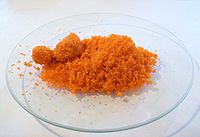- Sodium dichromate
-
Sodium dichromate.  Sodium dichromateOther namesDisodium salt
Sodium dichromateOther namesDisodium saltIdentifiers CAS number 10588-01-9  ,
,
7789-12-0 (dihydrate)PubChem 25408 ChemSpider 23723 
EC number 234-190-3 UN number 3288 ChEBI CHEBI:39483 
RTECS number HX7750000
HX7750000 (dihydrate)Jmol-3D images Image 1 - [Na+].[Na+].[O-][Cr](=O)(=O)O[Cr]([O-])(=O)=O
Properties Molecular formula Na2Cr2O7 Molar mass 261.97 g/mol (anhydrous)
298.00 g/mol (dihydrate)Density 2.52 g/cm3 Melting point 356.7 °C
dehydrates at 100 °CBoiling point decomposes 400 °C
Solubility in water 730 g/L at 25 °C Hazards MSDS ICSC 1369 EU Index 024-004-00-7 (anhydrous)
024-004-01-4 (dihydrate)EU classification Oxidant (O)
Carc. Cat. 2
Muta. Cat. 2
Repr. Cat. 2
Very toxic (T+)
Harmful (Xn)
Corrosive (C)
Dangerous for the environment (N)R-phrases R45, R46, R60, R61, R8, R21, R25, R26, R34, R42/43, R48/23, R50/53, S-phrases S53, S45, S60, S61 NFPA 704 LD50 50 mg/kg Related compounds Other anions Sodium chromate
Sodium molybdate
Sodium tungstateOther cations Potassium dichromate
Ammonium dichromate dichromate (verify) (what is:
dichromate (verify) (what is:  /
/ ?)
?)
Except where noted otherwise, data are given for materials in their standard state (at 25 °C, 100 kPa)Infobox references Sodium dichromate is the chemical compound with the formula Na2Cr2O7. Usually, however, the salt is handled as its dihydrate Na2Cr2O7·2H2O. Virtually all chromium ore is processed via conversion to sodium dichromate. In this way, many millions of kilograms of sodium dichromate are produced annually.[1] In terms of reactivity and appearance, sodium dichromate and potassium dichromate are very similar. The sodium salt is, however, around twenty times more soluble in water than the potassium salt (49 g/L at 0 °C) and its equivalent weight is also lower, which is often desirable.[2]
Contents
Production
Sodium dichromate is generated on a large scale from ores containing chromium(III) oxides. The ore is fused with a base, typically sodium carbonate, at around 1000 °C in the presence of air (source of oxygen):
- 2 Cr2O3 + 4 Na2CO3 + 3 O2 → 4 Na2CrO4 + 4 CO2
This step solubilizes the chromium and allows it to be extracted into hot water. At this stage, other components of the ore such as aluminium and iron compounds, are poorly soluble. Acidification of the resulting aqueous extract with sulfuric acid or carbon dioxide affords the dichromate, which is isolated at the dihydrate by crystallization. Since chromium(VI) is toxic, especially as the dust, such factories are subject to stringent regulations. For example, effluent from such refineries is treated with reducing agents to return any chromium(VI) to chromium(III), which is less threatening to the environment.[1] A variety of hydrates of this salt are known, ranging from the decahydrate below 19.5 °C (CAS# 13517-17-4) as well as hexa-, tetra-, and dihydrates. Above 62 °C, these salts lose water spontaneously to give the anhydrous material.
Reactions
Dichromate and chromate salts are oxidizing agents. For the tanning of leather, sodium dichromate is first reduced with sulfur dioxide.
In the area of organic synthesis,[2] this compound oxidizes benzylic and allylic C-H bonds to carbonyl derivatives. For example, 2,4,6-trinitrotoluene is oxidized to the corresponding carboxylic acid.[3]. Similarly, 2,3-dimethylnaphthalene is oxidized by Na2Cr2O7 to 2,3-naphthalenedicarboxylic acid.[4]
Secondary alcohols are oxidized to the corresponding ketone, e.g. menthol to menthone;[5] dihydrocholesterol to cholestanone:[6]
- 3 R2CHOH + Cr2O72- + 2 H+ → 3 R2C=O + Cr2O3 + 4 H2O
Relative to the potassium salt, the main advantage of sodium dichromate is its greater solubility in water and polar solvents like acetic acid.
Safety
Like all hexavalent chromium compounds, sodium dichromate is considered hazardous. It is also a known carcinogen[7].
References
- ^ a b Gerd Anger, Jost Halstenberg, Klaus Hochgeschwender, Christoph Scherhag, Ulrich Korallus, Herbert Knopf, Peter Schmidt, Manfred Ohlinger, "Chromium Compounds" in Ullmann's Encyclopedia of Industrial Chemistry, Wiley-VCH, Weinheim, 2005.
- ^ a b Freeman, F. "Sodium Dichromate" in Encyclopedia of Reagents for Organic Synthesis (Ed: L. Paquette) 2004, J. Wiley & Sons, New York. DOI: 10.1002/047084289.
- ^ Clarke, H. T.; Hartman, W. W. (1941), "2,4,6-Trinitrobenzoic Acid", Org. Synth., http://www.orgsyn.org/orgsyn/orgsyn/prepContent.asp?prep=cv1p0543; Coll. Vol. 1: 543
- ^ Friedman, L. (1973), "2,3-Naphthalenedicarboxylic Acid", Org. Synth., http://www.orgsyn.org/orgsyn/orgsyn/prepContent.asp?prep=cv5p0810; Coll. Vol. 5: 810
- ^ L. T. Sandborn (1929), "l-Menthone", Org. Synth. 9: 59, http://www.orgsyn.org/orgsyn/orgsyn/prepContent.asp?prep=cv1p0340; Coll. Vol. 1: 340
- ^ W. F. Bruce (1941), "Cholestanone", Org. Synth., http://www.orgsyn.org/orgsyn/orgsyn/prepContent.asp?prep=cv2p0139; Coll. Vol. 2: 139
- ^ ILO 1369 - Sodium Dichromate [1]
Sodium compounds NaAlO2 · NaBH3(CN) · NaBH4 · NaBr · NaBrO3 · NaCH3COO · NaCN · NaC6H5CO2 · NaC6H4(OH)CO2 · NaCl · NaClO · NaClO2 · NaClO3 · NaClO4 · NaF · NaH · NaHCO3 · NaHSO3 · NaHSO4 · NaI · NaIO3 · NaIO4 · NaMnO4 · NaNH2 · NaNO2 · NaNO3 · NaN3 · NaOH · NaO2 · NaPO2H2 · NaReO4 · NaSCN · NaSH · NaTcO4 · NaVO3 · Na2CO3 · Na2C2O4 · Na2CrO4 · Na2Cr2O7 · Na2MnO4 · Na2MoO4 · Na2O · Na2O2 · Na2O(UO3)2 · Na2S · Na2SO3 · Na2SO4 · Na2S2O3 · Na2S2O4 · Na2S2O5 · Na2S2O6 · Na2S2O7 · Na2S2O8 · Na2Se · Na2SeO3 · Na2SeO4 · Na2SiO3 · Na2Te · Na2TeO3 · Na2Ti3O7 · Na2U2O7 · NaWO4 · Na2Zn(OH)4 · Na3N · Na3P · Na3VO4 · Na4Fe(CN)6 · Na5P3O10 · NaBiO3
Categories:- Sodium compounds
- Chromates
- Oxidizing agents
Wikimedia Foundation. 2010.


